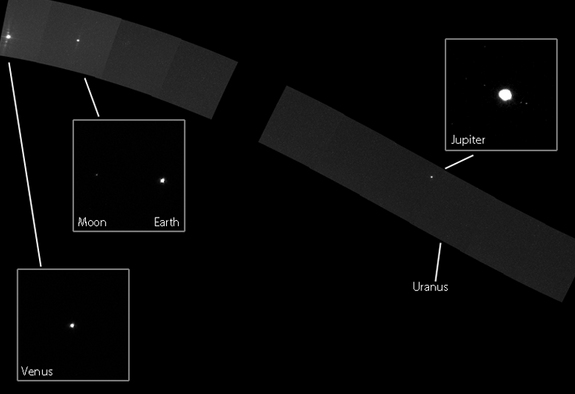Wow! 6 Solar System Planets Shine in One New Photo

A NASA spacecraft heading for Mercury has beamed to Earth an amazing space photo: A family portrait of six major planets in our solar system.
To make the planet photo mosaic, NASA's Messenger spacecraft snapped 34 individual images over a two-week period last November. Messenger mission scientists took those images and stitched them together into a single mosaic to build a view of our solar system as it appears from the center. [See the solar system planets portrait]
"This snapshot of our neighborhood also reminds us that Earth is a member of a planetary family that was formed by common processes four and a half billion years ago," said Messenger mission principal investigator Sean Solomon, of the Carnegie Institution of Washington, in a statement. "Our spacecraft is soon to orbit the innermost member of the family, one that holds many new answers to how Earth-like planets are assembled and evolve."
The Messenger spacecraft has flown by Mercury three times since its launch in 2004 and will arrive in orbit around the planet on March 18. Messenger's name is short for MErcury Surface, Space ENvironment, GEochemistry, and Ranging.
In the new photo, Messenger's cameras were able to spot all the major planets except Uranus and Neptune, which were too faint to detect, mission scientists said. Earth's moon and several of Jupiter's big moons – the Galilean satellites Callisto, Ganymede, Europa and Io – were also visible, and are highlighted in insets.
Bright Venus starts the portrait off at the far left, followed by Earth and its moon, and Jupiter. Messenger scientists then indicate where Uranus and Neptune were in their orbits at the time, and move on to show Mars, Mercury and Saturn.
The planets appear in a narrow S-shaped belt due to the tilted orbit of the Messenger spacecraft with respect to the ecliptic – or general plane – of the solar system.
Get the world’s most fascinating discoveries delivered straight to your inbox.
That made it a challenge to point Messenger's cameras in the right place to capture as many planets as it did. Scientists used a narrow-angle camera and a wide-angle camera on the spacecraft to make the planet portrait.
"It’s not easy to find a moment when many of the planets are within a single field of view from that perspective, and we have strong sun-pointing constraints on our ability to image in some directions," Solomon said.
The scientists used software to simulate the Messenger spacecraft's location to see which planets might be visible to its cameras. They also had to tweak some of Messenger's photos in order to bring out their planet targets. [Our Solar System from the Inside Out]
"The images are stretched to make it easier to detect the planets, though this stretch also highlights light scattered off of the planet limbs, and in some cases creates artifacts such as the non-spherical shape of some planets," explained Messenger imaging team member Brett Denevi of the Johns Hopkins University Applied Physics Laboratory in Laurel, Md.
Messenger mission scientists said the new planet portrait offers a reverse view of the solar system. In 1990, NASA's Voyager 1 spacecraft snapped a photo of the solar system as seen from the region of Neptune looking in.
"Seeing our solar system as just these little specks of light, it reminds you of how lucky we are that we've had the chance, through so many missions, to get up close and explore the incredible diversity and geology that each planet and moon displays," Denevi said. "Mercury has been just a dot on the horizon for most of history, and we get to fill in the details and know it as a real world. What an amazing opportunity!"
Follow SPACE.com on Twitter @Spacedotcom for the latest news from space.
This story was provided by SPACE.com, a sister site to LiveScience.




